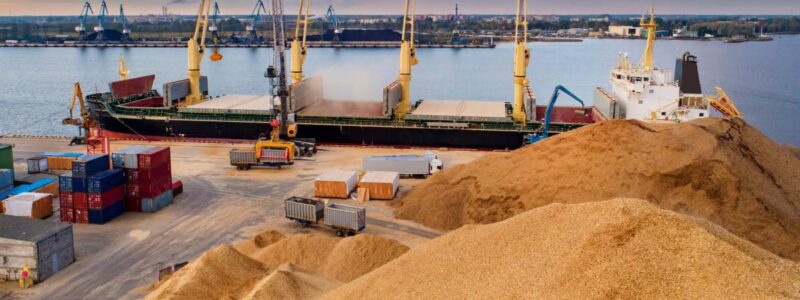
The flow of grain ships through the ports of Odessa Region is bringing long-awaited support to Ukraine’s economy. However, analysts warn that this may be a temporary phenomenon.
“In early March in Odessa, a 700-foot Liberian-flagged vessel slowly sailed out of the port, passing rows of yellow cranes and plunging into the calm waters of the Black Sea. Its hull was almost completely submerged as the ship was loaded with corn bound for Bangladesh. Meanwhile, other ships laden with grain have already left port, bypassing those that were just arriving,” the New York Times reported.
What seemed impossible last summer, when the Russian naval blockade paralyzed all commercial activity, is now a reality. The port was back on track thanks to a military campaign that drove Russian warships out of Ukrainian waters and provided a trade route for supplies to foreign markets.
Ukrainian grain and oilseed exports across the sea, which are vital to the Ukrainian economy, have almost returned to prewar levels, according to data provided to the New York Times. Over the past six months, Ukraine exported 27.6 million tons of grain and oilseeds across the Black Sea, only 0.2 million tons less than the average volume for the same period from 2018 to 2021 before Russia’s invasion in February 2022.
In the first quarter of this year, Black Sea exports even exceeded pre-war figures, according to Ukrainian data.
Grain and oilseed export estimates from Dragon Capital, a Kiev-based investment firm, and data from Lloyd’s List Intelligence, a shipping analytics firm, confirm this trend.
Sal Gilberti, head of Teucrium Trading, a U.S. company that trades agricultural commodities on the New York Stock Exchange, said claims by Ukrainian officials that grain exports across the sea are close to prewar levels are “accurate.”
Ukraine still faces challenges that could prevent grain exports from stabilizing at previous levels, including continued Russian attacks on port infrastructure and a reduced harvest this year. The U.S. Department of Agriculture predicts a decline in grain exports in the near future.
However, analysts say the overall environment is improving and freight companies are willing to transport Ukrainian grain despite the war. “The data shows there is no shortage of shipowners willing to take the risk and go for it,” said Greg Miller, senior maritime journalist at Lloyd’s List.
Maintaining high levels of grain exports is a strategic necessity for Ukraine. Grain and oilseeds accounted for a third of Ukrainian exports last year, said Natalia Spygotska, senior analyst at Dragon Capital. It has become critical to sustaining Ukraine’s economy and ultimately its war effort.
Tariel Khajishvili, head of Novik LLC, a Ukrainian ship agent operating in Odessa, said: “It is obvious that without grain exports, the country’s economy will collapse.”
After the invasion, Russia seized control of the Black Sea, blocking trade for months, jeopardizing global food security. In July 2022, a deal brokered by the UN and Turkey allowed Ukraine to resume exports through an agreed corridor in the Black Sea.
But a year later, Russia pulled out of the agreement and threatened all commercial ships traveling to or from Ukraine, leading to a complete halt to maritime grain exports last August.
To resume exports, the Ukrainian army launched a campaign to drive the Russian navy out of part of the Black Sea, destroying many warships and attacking their headquarters in Russia-occupied Crimea. The successful operation allowed Ukraine to create a new trade corridor along the coast that allows ships to enter the territorial waters of NATO countries.
Dmytro Barinov, deputy head of the Ukrainian Sea Ports Administration, recalls how nervous they were when the first grain ship passed through the corridor in mid-September: “We prayed that everything would go well.
Eventually, the ship successfully sailed into the open sea, and soon the “familiar pleasant sounds” of the ship’s sirens were again heard in Odessa.
The number of grain ships arriving at the three ports of the Odessa region – Odessa, Pivdennyi and Chernomorsk – increased to 231 in March from just 5 in September, according to Lloyd’s List.
Ukraine’s ship insurance arrangements with global insurers also contributed to the increase. Mr. Gilberti of Teucrium Trading added that Moscow is also interested in keeping the fighting out of the Black Sea, as it is also used to export Russian goods.
Today, Ukraine can only use ports in the Odessa region for grain exports, as other seaports are either too close to Russian positions or occupied by Russian troops. Despite this, with 4.1 million tons of grain and oilseeds shipped monthly, these three ports are close to pre-war export volumes.
The opening of the Odessa ports brought welcome financial relief to Ukraine. Having lost key economic assets during the war, such as steel mills in the east seized or destroyed by Russia, Ukraine is now more dependent on grain exports to support the economy. Dragon Capital predicted in the fall that a return to full operation of Odessa ports could add several percentage points to Ukraine’s GDP growth this year, which was forecast at 4 percent.
However, analysts warn that the initial success of Ukraine’s new trade route may be short-lived.
Russia continues to strike port infrastructure in Odessa, and with Ukraine’s air defenses in short supply, more missiles are reaching their target. In mid-April, Russia successfully struck two terminals in Pivdenne, destroying several containers.
Dragon Capital’s Ms. Spygotska also noted that high volumes of recent grain exports partly reflect shipments delayed by the Russian blockade, which could make it difficult to achieve those volumes in the future, especially with grain production projected to decline.
“Producers and exporters are now well positioned to export all available crops,” she said. “But it all depends on the harvest.”